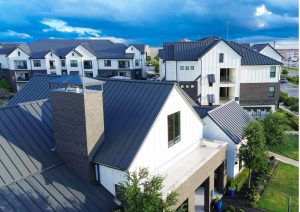
Zilker Roofing Project with Rental Property Roofing Replacement
5 Signs Your Rental Property’s Roof Needs Immediate Attention
Roof damage in Texas poses a serious risk to both your rental income and the long-term value of your property. Ignoring early signs can lead to structural issues, unhappy tenants, and costly emergency repairs.
According to IBISWorld, demand for roofing services across the state is driven by storm activity, aging housing stock, and the need for constant maintenance. Landlords should expect roof problems to happen, especially in areas with aging homes and frequent storms. If you’re not paying attention, you could be setting yourself up for emergency repairs, frustrated tenants, or worse.
Here are five signs that your rental property’s roof might need immediate attention and why waiting could cost you.
1. Water Stains or Leaks: The Silent Red Flag
Ceiling stains, peeling paint, and musty smells in the hallway are all signs of water intrusion. These often point to an ongoing roof leak. By the time you notice a brown spot on the ceiling, the damage may already be significant. Leaks can lead to insulation rot, electrical hazards, and mold growth behind the walls. Once tenants spot water damage, you can expect a call and possibly a complaint.
As this guide on roofing tips for property managers explains, addressing leaks early helps keep your maintenance costs lower and your tenant satisfaction higher. It is always better to stop a leak in month one than replace drywall and ceilings in month six.
2. Missing or Damaged Shingles: A Weak Link in the System
Shingles protect your roof from water, sunlight, wind, and physical damage. They form the first layer of defense against the elements. When a storm pulls up a few shingles, it creates a weak spot that water can easily exploit.
Most landlords don’t climb up to check after every storm, but it’s worth scheduling periodic inspections. Texas weather can change fast, and what looks like a few missing pieces can quickly turn into major roof damage.
If you haven’t checked your shingles lately, it’s a good time to start. Zilker Roofing’s roof repair page is a helpful place to learn about the signs of minor damage before it spreads.
3. Sagging or Uneven Rooflines: A Structural Emergency
A sagging roofline often signals a serious problem with the decking, rafters, or internal framing. It indicates structural damage that needs immediate attention. If you notice an uneven ridge or soft spots on the roof surface, it is time to act quickly. This type of damage should not be monitored, it should be fixed. Structural concerns can put your entire property at risk, not to mention tenant safety.
For landlords unsure where to start, a reputable local contractor like Zilker Roofing can provide a thorough inspection and help you understand if sagging is cosmetic or critical.
4. Granule Loss and Gutter Blockage
If you are seeing what looks like coarse sand in your gutters, that is granule loss, and it usually means your shingles are breaking down. Granules protect shingles from sun exposure. When they start falling off, the roof’s lifespan gets shorter.
Combine that with clogged gutters and you risk water backing up into fascia, siding, or even interior walls. These kinds of issues might seem small at first, but left untreated, they often require major repairs.
This overview on preventive maintenance and property protection explains how early intervention on small roof problems protects your rental investment over time.
5. Tenant Complaints About Temperature Swings
When tenants complain about inconsistent heating or cooling, most landlords look to the HVAC system, but the issue could be in the attic. Poor insulation or small roof leaks can throw off the system’s efficiency and raise energy bills.
These issues might not be obvious right away, but they add up. Poor climate control leads to unhappy tenants and higher turnover. Tenants who feel comfortable are more likely to stay. Keeping your roof sealed and properly insulated helps support that goal.
Even if the HVAC system is working well, check the roof. It might be costing you more than you realize.
What to Do If You Spot a Problem
The most important step is acting quickly. Take note of any signs such as stains, odors, or tenant complaints. Then schedule a roof inspection. Some companies offer free consultations or seasonal specials, which make it easier to stay ahead of issues before they become emergencies.
If you are unsure where to turn, reach out to a trusted local roofer who understands the challenges Texas properties face. Prompt repairs today can save you thousands in the future.
In Summary: Stay Proactive, Stay Profitable
Roof problems do not start big. They start small with a few granules in the gutter or a faint ceiling stain, and grow quietly until they force your hand. Small signs are easy to overlook, especially during busy turnover periods or routine inspections, but when ignored, those minor issues can become major repairs that disrupt leases, damage interiors, and lead to expensive emergency calls.
That’s why routine maintenance is critical for landlords. Make roof checks part of your seasonal schedule. Inspect after major storms, during daylight saving time changes, or whenever you service HVAC systems. Respond quickly to tenant concerns, and when in doubt, bring in a professional. Document repairs and keep a maintenance log so you can track patterns over time.
A well-maintained roof protects your investment, keeps tenants happy, and helps avoid unexpected costs that can eat into your profits. For Texas landlords, peace of mind starts at the top.
